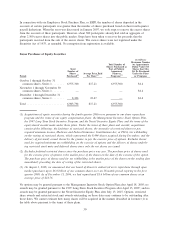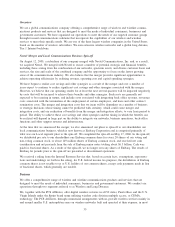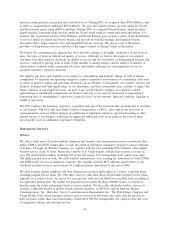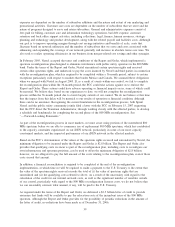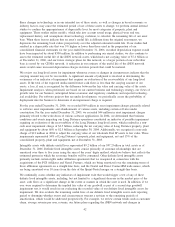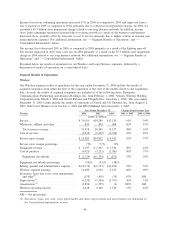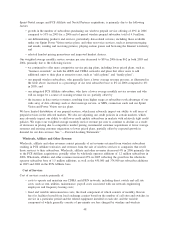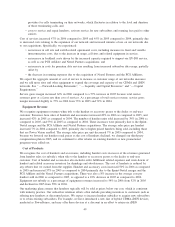Sprint - Nextel 2006 Annual Report Download - page 42
Download and view the complete annual report
Please find page 42 of the 2006 Sprint - Nextel annual report below. You can navigate through the pages in the report by either clicking on the pages listed below, or by using the keyword search tool below to find specific information within the annual report.Long Distance
Through our Long Distance segment, we provide a broad suite of wireline voice and data communications
services targeted to domestic business customers, multinational corporations and other communications
companies. These services include domestic and international data communications using various protocols,
such as multi-protocol label switching, or MPLS, technologies, Internet Protocol, or IP, asynchronous transfer
mode, or ATM, frame relay, managed network services and voice services. We also provide services to the
cable MSOs that resell our long distance service and/or use our back office systems and network assets in
support of their telephone service provided over cable facilities primarily to residential end-user customers.
We are one of the nation’s largest providers of long distance services and operate all-digital long distance and
Tier 1 IP networks.
For several years, our long distance voice services have experienced an industry-wide trend of lower revenue
from lower prices and competition from other wireline and wireless communications companies, as well as
cable MSOs and Internet service providers. Growth in voice services provided by cable MSOs is accelerating
as consumers use cable MSOs as alternatives to local and long distance voice communications providers. We
continue to assess the portfolio of services provided by our Long Distance segment and are focusing our
efforts on IP-based services and de-emphasizing stand-alone voice services and non-IP-based data services.
For example, in addition to increased emphasis on selling IP services, we are converting many of our existing
customers from ATM and frame relay to more advanced IP technologies, in part to support our effort to move
to one platform, which will reduce our cost structure. Over time, this conversion is expected to result in
decreases in revenue from frame relay and ATM service offset by increases in IP and MPLS services. We also
are taking advantage of the growth in voice services provided by cable MSOs, by providing large cable MSOs
with long distance voice communications service, which they offer as part of their bundled service offerings.
Critical Accounting Policies and Estimates
We consider the following accounting policies and estimates to be the most important to our financial position
and results of operations, either because of the significance of the financial statement item or because they
require the exercise of significant judgment and/or use of significant estimates. While management believes
that the estimates used are reasonable, actual results could differ from those estimates.
Revenue Recognition and Allowance for Doubtful Accounts Policies
Operating revenues primarily consist of wireless service revenues, revenues generated from handset and
accessory sales and revenues from wholesale operators and PCS Affiliates, as well as long distance voice, data
and Internet revenues. Service revenues consist of fixed monthly recurring charges, variable usage charges and
miscellaneous fees, such as activation fees, directory assistance, operator-assisted calling, equipment protec-
tion, late payment charges and certain regulatory related fees. We recognize service revenues as services are
rendered and equipment revenue when title passes to the dealer or end-user customer, in accordance with SEC
Staff Accounting Bulletin, or SAB, No. 104, Revenue Recognition, and Emerging Issues Task Force, or EITF,
Issue No. 00-21, Revenue Arrangements with Multiple Deliverables. We recognize revenue for access charges
and other services charged at fixed amounts ratably over the service period, net of credits and adjustments for
service discounts, billing disputes and fraud or unauthorized usage. We recognize excess wireless usage and
long distance revenue at contractual rates per minute as minutes are used. Additionally, we recognize excess
wireless data usage based on kilobytes and one-time use charges, such as for the use of premium services, as
incurred. As a result of the cutoff times of our multiple billing cycles each month, we are required to estimate
the amount of subscriber revenues earned but not billed from the end of each billing cycle to the end of each
reporting period. These estimates are based primarily on rate plans in effect and our historical usage and
billing patterns and represented about 13% of our accounts receivable balance as of December 31, 2006.
Certain of our bundled products and services, primarily in our Wireless segment, are considered to be revenue
arrangements with multiple deliverables. Total consideration received in these arrangements is allocated and
measured using units of accounting within the arrangement (i.e., service and handset contracts) based on
relative fair values. The activation fee revenue associated with these arrangements in our direct sales channels
40


